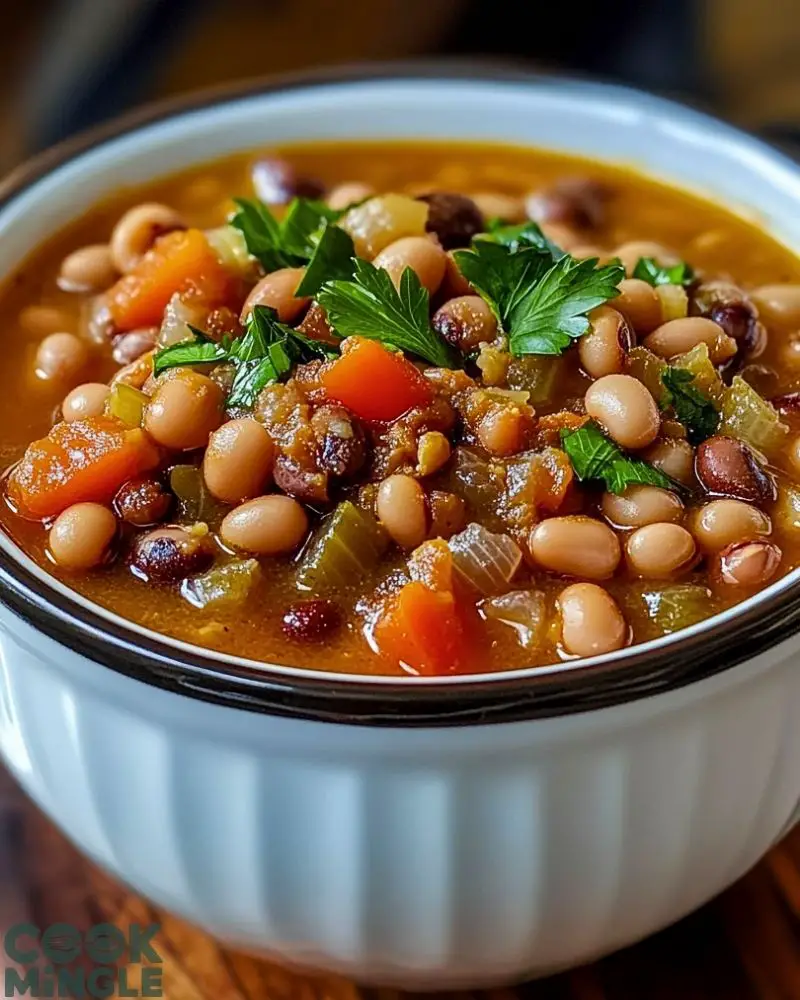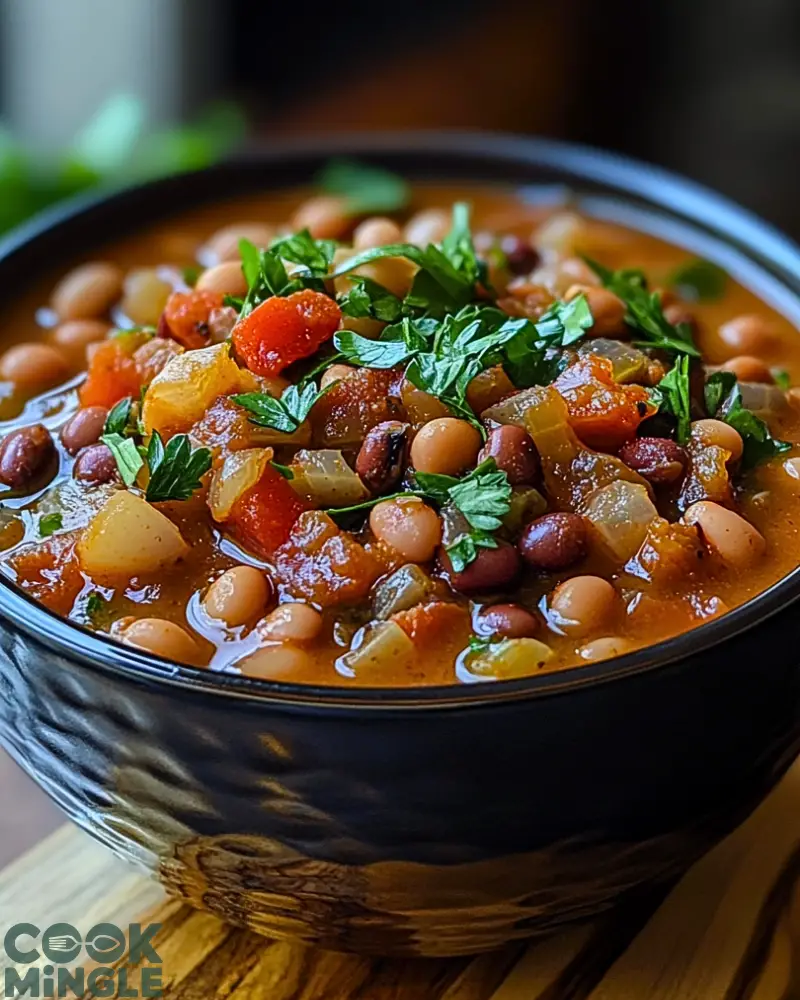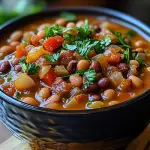Few dishes embody comfort quite like a hearty bowl of Black-Eyed Pea Soup. This timeless classic is a rich tapestry of flavor, combining tender black-eyed peas, aromatic vegetables, and a savory broth infused with herbs and spices. With roots in Southern kitchens and global appeal, it’s the kind of meal that makes you slow down, savor each bite, and feel nourished from the inside out.

Whether you’re cooking up a cozy weeknight dinner or preparing a big-batch lunch for the week, this soup is packed with wholesome goodness. It’s naturally protein-rich, fiber-filled, and deeply satisfying—plus it’s budget-friendly and easy to prepare. From the first spoonful, you’ll get a medley of texture: the soft creaminess of the peas, the bite of diced veggies, and the subtle kick of seasoning that brings everything together.
Why You’ll Love This Black-Eyed Pea Soup
- Deeply comforting: Ideal for chilly nights or when you need a hug in a bowl.
- Nutritious and filling: Packed with protein, fiber, and essential nutrients.
- Budget-friendly: Uses pantry staples and basic produce.
- Easy to customize: Add sausage, greens, or spice it up!
- Meal prep star: It stores well and tastes even better the next day.
Preparation Phase & Tools to Use
Essential Tools and Equipment (and Why They Matter)
To make your Black-Eyed Pea Soup smooth-sailing from start to finish, a few trusty kitchen tools will make all the difference. Here’s what you’ll need and why:
- Large Heavy-Bottomed Pot or Dutch Oven – This is the heart of your cooking. A thick-bottomed pot ensures even heat distribution, which is crucial for simmering your soup gently without burning the base.
- Sharp Chef’s Knife – Chopping vegetables finely and evenly not only helps them cook uniformly but also enhances texture and presentation.
- Cutting Board – A stable surface makes prep work safer and quicker. Wooden or plastic boards are ideal.
- Wooden Spoon or Silicone Spatula – For stirring your ingredients without scratching your cookware.
- Measuring Cups and Spoons – Precision matters, especially with seasoning and broth quantities.
- Colander or Sieve – To rinse your black-eyed peas thoroughly, especially if using canned or soaked dried peas.
Having these tools prepped and ready before you start will help you cook confidently and keep your kitchen stress-free.
Preparation Tips
- Soaking Dried Peas: If you’re using dried black-eyed peas, soak them overnight or do a quick soak by boiling for 2 minutes and letting them rest, covered, for an hour. This shortens cooking time and improves digestibility.
- Sauté Before Simmering: Start by sautéing onions, garlic, and celery to create a flavor base that lifts the whole dish.
- Layer the Seasoning: Don’t dump everything in at once. Season in stages—some with your aromatics, some mid-way, and a final taste-check at the end.
- Go Low and Slow: Let the soup simmer on low heat to give the ingredients time to meld together beautifully.
- Make It Yours: Add smoked paprika, bay leaves, thyme, or even a splash of vinegar at the end to brighten the flavor.
Taking a few extra steps during preparation gives your soup depth, richness, and irresistible aroma that’ll make everyone ask for seconds.
Ingredients for This Black-Eyed Pea Soup
This soul-soothing Black-Eyed Pea Soup is built on simple, hearty ingredients that you probably already have in your pantry and fridge. Each one brings something essential—flavor, texture, or nutrition.
Core Ingredients:
- 2 tablespoons olive oil – For sautéing and building a rich flavor base.
- 1 medium yellow onion, diced – Adds sweetness and depth.
- 2 celery stalks, chopped – Brings a subtle crunch and earthy flavor.
- 2 medium carrots, chopped – Adds a touch of natural sweetness and color.
- 3 garlic cloves, minced – Infuses a warm, aromatic base.
- 1½ cups dried black-eyed peas (or 2 cans, drained and rinsed) – The star of the soup, creamy and protein-packed.
- 6 cups vegetable broth or water – The liquid that carries all the flavors; use broth for a more savory result.
- 1 teaspoon smoked paprika – Adds a smoky, slightly spicy undertone.
- 1 teaspoon dried thyme – Herbaceous and woodsy, perfect with legumes.
- ½ teaspoon ground cumin – Brings warmth and depth.
- Salt and black pepper to taste – Essential for flavor balance.
- 1 bay leaf – Subtle and fragrant, it elevates the broth as it simmers.
Optional Add-ins:
- 1 cup chopped tomatoes (fresh or canned) – For added body and slight tanginess.
- 2 cups chopped greens (spinach, kale, or collards) – For extra nutrients and color.
- A dash of hot sauce or red pepper flakes – If you enjoy a kick of heat.
- Fresh parsley or cilantro, chopped – As garnish for a fresh, bright finish.
This lineup gives you a solid, flexible foundation. You can easily build on it by adding sausage, ham hocks, or plant-based protein if you’d like to give the dish your own spin.

Step-by-Step Instructions for Making Black-Eyed Pea Soup
Creating this nourishing Black-Eyed Pea Soup is simple and satisfying. Follow these steps for a cozy, flavor-packed bowl every time:
Step 1: Prep the Vegetables
Begin by dicing your onions, carrots, and celery, and mincing the garlic. If using fresh tomatoes or greens, chop those as well. Having everything prepped ahead makes cooking smoother.
Step 2: Sauté the Aromatics
In a large heavy-bottomed pot or Dutch oven, heat the olive oil over medium heat.
Add the onions, carrots, and celery. Cook for about 6–7 minutes until the veggies are soft and fragrant.
Stir in the garlic and cook for another 1–2 minutes, just until golden and aromatic.
Step 3: Add Seasonings and Black-Eyed Peas
Toss in the smoked paprika, thyme, cumin, salt, and pepper. Stir to coat the vegetables evenly in the spices.
Then add your black-eyed peas (soaked or canned) and give everything a good mix.
Step 4: Pour in Broth and Simmer
Add the vegetable broth or water and drop in the bay leaf. Bring to a gentle boil, then reduce the heat to low.
Cover and simmer:
- If using dried peas: simmer for 45–60 minutes, or until tender.
- If using canned peas: simmer for 20–25 minutes to allow flavors to meld.
Step 5: Add Tomatoes and Greens (Optional)
During the last 10–15 minutes of simmering, stir in your chopped tomatoes and greens if using.
Let them cook down until tender and well-blended into the soup.
Step 6: Final Taste and Garnish
Remove the bay leaf. Taste and adjust seasoning—add more salt, pepper, or even a splash of lemon juice or vinegar to brighten the flavor.
Ladle into bowls and garnish with fresh herbs like parsley or cilantro.
Notes
- Make It Ahead: This soup is one of those magical recipes that tastes even better the next day. The flavors deepen and mellow overnight, making it a perfect meal-prep option.
- Dried vs. Canned: Dried black-eyed peas provide a firmer texture and richer taste, but canned peas are perfect for when you’re short on time. Just be sure to rinse them thoroughly.
- Flavor Boosters: For a richer depth, you can sauté a spoonful of tomato paste with the aromatics or toss in a parmesan rind or smoked ham bone during simmering.
- Make It Spicy: Add chopped jalapeños with the vegetables or stir in some cayenne or chili flakes while seasoning.
- Garnish Options: Fresh herbs, a dollop of yogurt, or even a drizzle of olive oil can elevate the presentation and flavor.
Watch Out for These Mistakes While Cooking
- Skipping the Sauté Step: It might be tempting to throw everything in at once, but sautéing aromatics first develops a richer, layered flavor base. Don’t rush this part.
- Overcooking the Peas: While black-eyed peas are fairly forgiving, they can become mushy if overcooked. Keep an eye on them and test for doneness.
- Underseasoning: Soup needs more salt than you think, especially when using water instead of broth. Taste and adjust as you go.
- Not Soaking Dried Peas: If you forget to soak dried peas, they’ll take much longer to cook and may not cook evenly.
- Using Too Much Liquid: Adding excess broth can dilute flavors. Start with the recommended amount and add more only if needed.
- Skipping Acidity at the End: A splash of lemon juice or vinegar can brighten the entire dish. Don’t skip this—it brings everything to life.
- Neglecting Texture: If your soup feels flat, try blending a small portion and stirring it back in for a creamier body.
What to Serve With Black-Eyed Pea Soup?
Black-Eyed Pea Soup is a hearty, standalone meal—but pairing it with the right sides can make it even more satisfying and well-rounded. Whether you’re hosting a cozy dinner or just want to elevate a weeknight meal, these complementary dishes will complete the experience beautifully.
### 8 Delicious Serving Ideas:
- Cornbread
A golden slice of Southern-style cornbread is the perfect companion. It soaks up the flavorful broth and adds a touch of sweetness and texture. - Crusty Artisan Bread
Serve it toasted or fresh, with a slather of butter. The chewy crust contrasts beautifully with the softness of the soup. - Garlic Greens (like collards or kale)
A side of sautéed greens with garlic and lemon brightens the dish and complements the earthy notes of the peas. - Simple Garden Salad
Toss together mixed greens, cherry tomatoes, cucumbers, and a tangy vinaigrette to refresh your palate between bites. - Rice or Quinoa
Scoop some into the bowl or serve it underneath the soup for a more filling, stew-like version. - Grilled Cheese or Melty Sandwich
A gooey sandwich on the side adds comfort and indulgence—perfect for dunking. - Roasted Sweet Potatoes
Their natural sweetness balances the savory, smoky soup flavors and adds a satisfying texture. - Pickled Vegetables or Relish
A tart, crunchy contrast like pickled onions or chow-chow adds zing and livens up the entire dish.
Storage Instructions
One of the best things about Black-Eyed Pea Soup is how well it stores. Whether you’re meal prepping for the week or saving leftovers, it’s super easy to keep this dish fresh and flavorful.
- Refrigerator: Store the soup in an airtight container for up to 5 days. The flavors will actually deepen over time, making it even tastier the next day.
- Freezer: This soup freezes beautifully. Let it cool completely before transferring to freezer-safe containers or zip-top bags (lay them flat for easy storage). Freeze for up to 3 months.
- Reheating: Reheat on the stovetop over medium heat or in the microwave. If the soup has thickened, just add a splash of broth or water to loosen it back up.
Pro Tip: If you’re planning to freeze it, wait to add delicate greens (like spinach) until reheating, as they can become mushy when thawed.
Estimated Nutrition (Per Serving – based on 6 servings)
Note: Nutritional values can vary depending on added ingredients like sausage, broth type, or garnishes.
- Calories: ~220 kcal
- Protein: 11g
- Fat: 5g
- Carbohydrates: 35g
- Fiber: 9g
- Sugar: 5g
- Sodium: 420mg
- Iron: 15% DV
- Vitamin A: 35% DV
- Vitamin C: 12% DV
This soup is low in fat, high in fiber and plant-based protein, and naturally gluten-free—making it a fantastic option for a wholesome lunch or dinner.
Frequently Asked Questions
### 1. Can I make Black-Eyed Pea Soup in a slow cooker?
Absolutely! Just sauté the aromatics first, then add everything to your slow cooker. Cook on low for 6–8 hours or high for 3–4 hours if using soaked dried peas (or 2–3 hours for canned peas).
2. How do I make this soup vegetarian or vegan?
It already is! Just ensure your broth is vegetable-based. For added richness, a splash of coconut milk or a drizzle of olive oil at the end is a great touch.
3. Can I add meat to this soup?
Yes! Smoked sausage, diced ham, bacon, or even shredded rotisserie chicken are all great additions. Add them after sautéing the veggies or during the simmer phase.
4. What if I forgot to soak my dried black-eyed peas?
No worries. You can do a quick soak by boiling them for 2 minutes, then letting them sit (covered) for 1 hour. Or just cook them longer—expect an extra 30–40 minutes of simmering.
5. Can I blend part of the soup for a creamier texture?
Definitely. Remove about 1–2 cups of the soup, blend until smooth, and stir it back in. It thickens the broth while keeping the rest chunky and hearty.
6. Is this recipe gluten-free?
Yes, it’s naturally gluten-free. Just double-check your broth and any add-ins to ensure they’re certified gluten-free if you have a sensitivity.
7. How spicy is this soup?
It’s mildly seasoned but not spicy. If you like heat, add red pepper flakes, jalapeños, or hot sauce to taste.
8. What’s the best way to reheat leftovers?
Use the stovetop over medium heat or microwave in intervals. If the soup thickens too much in the fridge, stir in a little broth or water to adjust the consistency.
Conclusion
Black-Eyed Pea Soup is the kind of recipe that blends simplicity with soul. It’s deeply comforting, endlessly customizable, and packed with nourishing ingredients that will leave you feeling full and satisfied. Whether you’re cooking for family, friends, or just yourself, this is a dish that’s meant to be shared, savored, and remembered.
From its humble roots to its big, bold flavor, this soup proves that hearty, healthy meals don’t have to be complicated. Just one pot, a handful of pantry staples, and a little patience—and you’ve got something special simmering on the stove.

Black-Eyed Pea Soup
- Total Time: 1 hour
- Yield: 6 servings
Description
Warm, hearty, and bursting with flavor, Black-Eyed Pea Soup is the ultimate cozy comfort food. This easy dinner idea comes together with everyday ingredients like black-eyed peas, carrots, celery, garlic, and aromatic herbs, simmered into a savory broth. It’s a healthy, protein-packed soup perfect for a quick lunch, a nourishing dinner, or weekly meal prep. Whether you’re looking for a wholesome vegan dish, a gluten-free comfort bowl, or easy food ideas for cooler days, this recipe has you covered. It’s rich, rustic, and full of love—perfect for any day you need a warm, satisfying meal.
Ingredients
- 2 tablespoons olive oil
- 1 medium yellow onion, diced
- 2 celery stalks, chopped
- 2 medium carrots, chopped
- 3 garlic cloves, minced
- 1½ cups dried black-eyed peas (or 2 cans, drained and rinsed)
- 6 cups vegetable broth or water
- 1 teaspoon smoked paprika
- 1 teaspoon dried thyme
- ½ teaspoon ground cumin
- Salt and black pepper to taste
- 1 bay leaf
Optional Add-ins:
- 1 cup chopped tomatoes
- 2 cups chopped greens (spinach, kale, or collards)
- Red pepper flakes or hot sauce for spice
- Fresh parsley or cilantro for garnish
Instructions
-
Dice all vegetables and mince the garlic.
-
Heat olive oil in a large pot over medium heat. Add onion, carrots, and celery. Sauté for 6–7 minutes.
-
Stir in garlic, smoked paprika, thyme, cumin, salt, and pepper. Cook for 1–2 minutes more.
-
Add black-eyed peas and stir to coat.
-
Pour in broth and drop in the bay leaf. Bring to a boil, then reduce heat and simmer:
-
45–60 mins for dried peas
-
20–25 mins for canned peas
-
-
During the last 10–15 minutes, add chopped tomatoes and greens (if using).
-
Remove the bay leaf. Taste and adjust seasoning.
-
Serve hot, garnished with fresh herbs or a splash of lemon juice.
- Prep Time: 15 minutes
- Cook Time: 45 minutes

